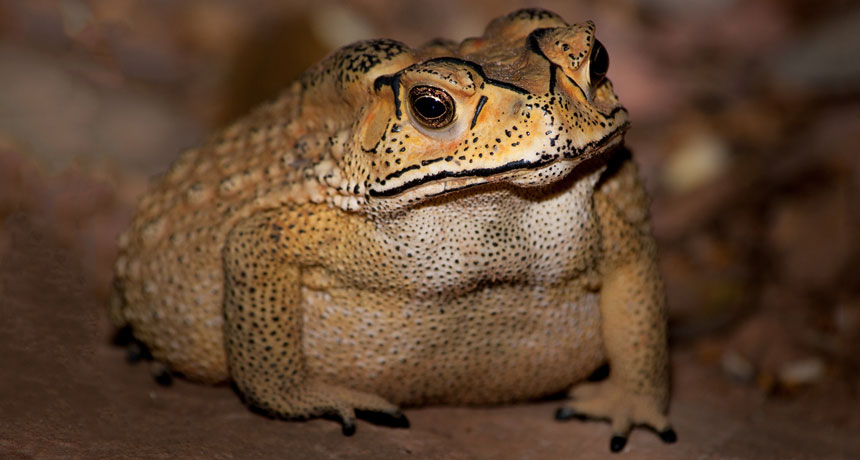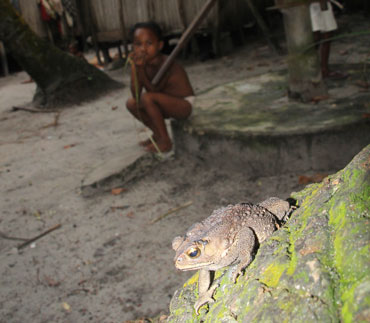Toxic toads pose threat to Madagascar’s predators
Genetic study finds that nearly all predators would be vulnerable to the toad’s poison

The skin of the Asian common toad is laced with a natural poison. This species is now spreading across the island of Madagascar. Predators are not likely to keep the invaders in check, a new study finds. Only one appears immune to the toad’s deadly toxin.
Benjamin Marshall
The skin of the common Asian toad contains a poison that can kill nearly anything that tries to eat the amphibian. Eight to 10 years ago, the toad arrived in Madagascar. That’s bad news for the unique wildlife that have evolved on this island nation off the coast of East Africa. A new genetic study shows that the toad’s toxin could likely kill nearly any of the island’s predators.
Scientists had suspected this for years. However, they had lacked data to confirm just how dangerous the toads could be. Now, they have it.
For tens of millions of years, Madagascar’s wildlife has been isolated from the rest of the world. “It’s never had toads,” notes Wolfgang Wüster. He’s a herpetologist at Bangor University in Wales. So why, he asks, “would the local animals be resistant to toads? We always expected them to be sensitive.” As a result of the new study, he says, “we have much better evidence that that’s really the case.”

Duttaphrynus melanostictus (Dut-tah-FRY-nus Mel-ah-noh-STRICT-us) is one of many toad species that secrete potent toxins. These poisons can disrupt the flow of sodium and potassium across cell membranes. That flow is critical for the proper function of muscles, especially in the heart.
If they are not resistant to the toxins, “[predators] that take a mouthful of toad can die extremely quickly from heart failure,” notes Wüster.
The common Asian toad likely stowed away on some ship in Asia. It may have been leaving Vietnam’s capital, Ho Chi Minh City. From there, the toads hitched a ride to Madagascar. They now are spreading slowly across the large island.
Some species in parts of the world where toxic toads are found — including certain reptiles and mammals — have evolved resistance to toad toxin. In 2015, Wüster was part of a research team that showed resistant animals shared something in common. All had specific mutations — changes — in a gene for their cells’ sodium-potassium pump. “That’s a universal mechanism for being able to consume toads — and particularly to deal with [their] toxins,” says Wüster.
Toxic toads have become invasive species in several parts of the world. Cane toads, for instance, have been spreading across northern Australia for decades. That has led to declines of native species, such as quolls and snakes. That invasion is well-studied. Scientists there know a lot about the species affected by it. That’s why there’s little need there to start looking for species that are immune to the toxin. More recently, though, toxic toads have invaded places such as Indonesia and Madagascar. There, such data might be helpful.
So Wüster and his colleagues looked at the gene for the sodium-potassium pump in 77 species from Madagascar. Their list included 28 birds, eight mammals and 27 snakes. Only one species, a rodent known as the white-tailed antsangy, had the mutations that would make it immune to the toad toxin. The toxin would likely be able to kill all 76 other species. The researchers reported their finding June 4 in Current Biology.
Madagascar’s wildlife is likely not entirely doomed. In Australia, scientists have documented behavioral changes in some predators that have allowed them to safely eat toads. Some birds, for instance, have learned that toad tongues are safe to eat. Some Madagascar species might similarly figure out how to safely make a meal of the toads. Or they could learn to simply not eat the toads.
People might help, too. It’s probably too late to remove all of the toxic toads from Madagascar. There are already too many of them. What’s more, there’s no good way to easily find and kill them all. But this research may help scientists in Madagascar take measures to protect certain species or sites from toads, Wüster says.







